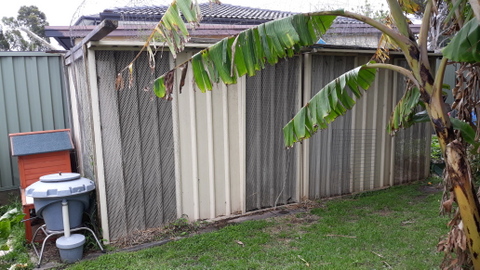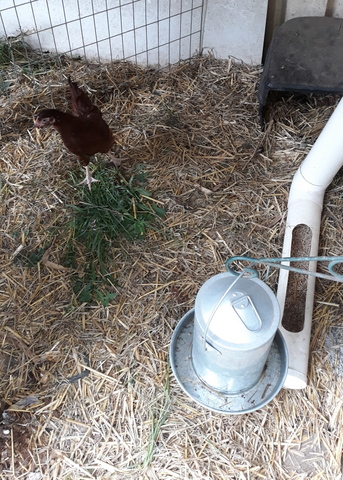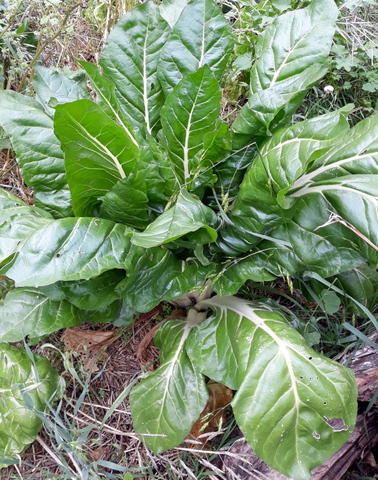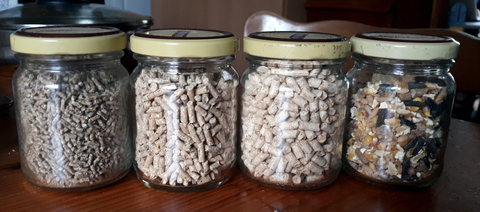The Retirement Village
There comes a time in each chooks life where they get a bit old and tired to do the work in the chook tractor, and they stop laying eggs! So the question that needs to be answered is – ‘what are ya gonna do?’ You could eat them, but the fact is that after a lifetime of service we don’t. So we developed the retirement village.
The concept of the retirement village was developed some time after we implemented the chook tractor idea. I found a couple of well-ventilated aviary sheds that were redundant stock and were being sold off comparatively cheaply by the retailer I bought both with the idea that one would become our worm shed and the other the retirement village.

Both sheds are exactly the same. They are made of Colourbond steel of the ‘stand up and screw together’ type of construction 2.4 metres wide x 1.6 metres deep x 1. Metres high, with some panels being perforated with 10mm holes. The perforated panels are the left and right front panels (the right hand one of which is the door) and one panel on the left and right hand side of the front of the shed so that the left and right front corners are perforated. I installed the sheds on the northern boundary so that they would not take up valuable growing space.
I put down some 600mm x 600mm concrete pavers as the base and then constructed the sheds on top and after adding some hooks in the roof, tied up a feeder and a waterer and installed a diagonal perch so they could perch and see out through the perforations. I did find that the perforated wall which faced west let in too much of that western Sydney sun in summer, so covered it up on the inside with an old internal door we no longer needed.
The concrete floor is covered with straw (or locally grown grass hay when I can get it) which is sort of a deep litter system. This has a number of things going for it but the main one is chooks turn the straw over and consume any residual wheat grains and break the straw down a bit and I shovel out the straw and use it as mulch. The other advantage of this system is that there is no concentration of chook poop to deal with. It is mostly turned over and mixed with the straw, so it all gets shovelled out when I am applying the mulch.

They do occasionally provide eggs as well and I installed an old grass catcher in the corner of the shed for the chooks to lay in when they feel the need. This most often happens in early spring but we can get eggs at other times of the year. The retired chooks spend most of their time in the retirement village, but do get let out on occasion, generally in a wire pen to assist with bed clearing if required or to take advantage of fallen mulberries under our large mulberry tree in the front yard.
Feeding
Our backbone, go to feed for the chooks are free range layer pellets. I would like to grow and mix our own feed but it isn’t practical for us. Having said that, we do produce all the green pick the chooks can eat, either self-harvested in the tractor or harvested by me for the retirement shed chooks. They could be leftover harvest of silver beet or more likely grabbing some edible ‘weeds’ growing around the yard, and yes we will partake of them too.

When the chooks were in their sedentary coop and run we used to also feed them scratch mix, which is a mix of seeds and grain which you can toss around and they pick what they want up off the ground. It made a nice end of the day to see them pecking around for their supper. Unfortunately I continued the tradition when they moved into the tractor/retirement village system, but stopped pretty quickly when the practice resulted in a world class weed infestation in each bed in turn as the tractor moved off it. We don’t use scratch mix anymore!

They do get treats. These may be in the form of food scraps, peelings, stale bread or whatever, or pest caterpillars pulled of brassicas or other veggies. I don’t think of such actions in terms of pest control, but rather harvesting chook treats! They also get chilled fruit, like grapes or watermelon on the hot summer afternoons to try and make things more comfortable for them.
Companionship
One of the unexpected benefits of the chooks has been companionship while working in the back yard. Some years ago the family and I went to Belgium for Christmas to meet and spend some time with my son-in-law’s parents, but I was going on frequent flier points so I left three days later. We were going for over a month so I had taken the chooks over to a friend’s place to be looked after while we were away. I was amazed how ‘dead’ the backyard felt without the chooks being there, and the companionship they brought, just by their presence in the back yard!
Conclusion
Our journey with chooks has been interesting and certainly beneficial in all sorts of ways which I did not consider when we first got them. We have learned a lot too, sometimes through training (I did chooks as part of the Farm Tech certificate back in the late ‘80s), through reading and through just plain experience. I now have the happy opportunity of running chook workshops for local councils, so I get to share some of what we have learned. I have also had the pleasure of seeing friends who resisted getting chooks, finally getting them and finding out what a joy they are. So my advice to you if you are considering chooks is go for it! (but do some homework first!)




